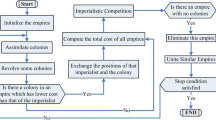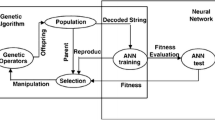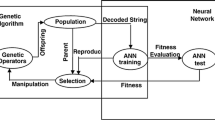Abstract
Blasting operations usually produce significant environmental problems which may cause severe damage to the nearby areas. Air-overpressure (AOp) is one of the most important environmental impacts of blasting operations which needs to be predicted and subsequently controlled to minimize the potential risk of damage. This paper presents three non-linear methods, namely empirical, artificial neural network (ANN), and imperialist competitive algorithm (ICA)-ANN to predict AOp induced by blasting operations in Shur river dam, Iran. ICA as a global search population-based algorithm can be used to optimize the weights and biases of the network connection for training by ANN. In this study, 70 blasting operations were investigated and relevant blasting parameters were measured. The most influential parameters on AOp, namely maximum charge per delay and the distance from the blast-face, were considered as input parameters or predictors. Using the five randomly selected datasets and considering the modeling procedure of each method, 15 models were constructed for all predictive techniques. Several performance indices including coefficient of determination (R 2), root mean square error and value account for were utilized to check the performance capacity of the predictive methods. Considering these performance indices and using simple ranking method, the best models were selected among all constructed models. It was found that the ICA-ANN approach can provide higher performance capacity in predicting AOp compared to other predictive methods.












Similar content being viewed by others
References
Shirani Faradonbeh R, Monjezi M, Jahed Armaghani D (2015) Genetic programing and non-linear multiple regression techniques to predict backbreak in blasting operation. Eng Comput. doi:10.1007/s00366-015-0404-3
Khandelwal M, Kankar PK (2011) Prediction of blast-induced air overpressure using support vector machine. Arabian J Geosci 4:427–433
Khandelwal M, Kumar DL, Yellishetty M (2011) Application of soft computing to predict blast-induced ground vibration. Eng Comput 27(2):117–125
Jahed Armaghani D, Hajihassani M, Mohamad ET, Marto A, Noorani SA (2014) Blasting-induced flyrock and ground vibration prediction through an expert artificial neural network based on particle swarm optimization. Arab J Geosci 7:5383–5396
Hajihassani M, Jahed Armaghani D, Marto A, Tonnizam Mohamad E (2014) Ground vibration prediction in quarry blasting through an artificial neural network optimized by imperialist competitive algorithm. Eng. Geol. Environ, Bull. doi:10.1007/s10064-014-0657-x
Kuzu C (2008) The importance of site-specific characters in prediction models for blast-induced ground vibrations. Soil Dynamic Earthq Eng 28:405–414
Singh TN, Dontha LK, Bhardwaj V (2008) Study into blast vibration and frequency using ANFIS and MVRA. Mining Technology 117(3):116–121
Konya CJ, Walter EJ (1990) Surface blast design. Prentice Hall, Englewood Cliffs
Hopler RB, (1998) editor. Blasters’ handbook. International Society of Explosives Engineers
Sawmliana C, Roy PP, Singh RK, Singh TN (2007) Blast induced air overpressure and its prediction using artificial neural network. Mining Technology 116(2):41–48
Siskind DE, Stachura VJ, Stagg MS, Koop JW, 1980. In: Siskind DE, editor. Structure response and damage produced by airblast from surface mining. United States Bureau of Mines
Hustrulid WA, 1999. Blasting principles for open pit mining: general design concepts. Balkema.
Kuzu C, Fisne A, Ercelebi SG (2009) Operational and geological parameters in the assessing blast induced airblast-overpressure in quarries. Appl Acoust 70:404–411
Hajihassani M, Jahed Armaghani D, Sohaei H, Mohamad ET, Marto A (2014) Prediction of airblast-overpressure induced by blasting using a hybrid artificial neural network and particle swarm optimization. Appl Acoust 80:57–67
Tonnizam Mohamad T, Jahed Armaghani DJ, Noorani SA, Saad R, Alavi Nezhad SV (2012) Prediction of flyrock in boulder blasting using artificial neural network. Elect J Goetech Eng 17:2585–2595
Jahed Armaghani D, Tonnizam Mohamad E, Momeni E, Narayanasamy MS, Mohd Amin MF (2014) An adaptive neuro-fuzzy inference system for predicting unconfined compressive strength and Young’s modulus: a study on Main Range granite. Bull Eng Geol Environ. doi:10.1007/s10064-014-0687-4
Monjezi M, Hasanipanah M, Khandelwal M (2013) Evaluation and prediction of blast-induced ground vibration at Shur River Dam, Iran, by artificial neural network. Neural Comput Appl 22:1637–1643
Momeni E, Nazir R, Jahed Armaghani D, Maizir H (2014) Prediction of pile bearing capacity using a hybrid genetic algorithm-based ANN. Measurement 57:122–131
Trivedi R, Singh TN, Raina AK (2015) Prediction of blast-induced flyrock in Indian limestone mines using neural networks. Journal of Rock Mechanics and Geotechnical Engineering 6(5):447–454
Wang XG, Tang Z, Tamura H, Ishii M, Sun WD (2004) An improved backpropagation algorithm to avoid the local minima problem. Neurocomputing 56:455–460
Adhikari R, Agrawal RK (2011) Effectiveness of PSO based neural network for seasonal time series forecasting. Indian International Conference on Artificial Intelligence (IICAI). Tumkur, India, pp 232–244
Taghavifar H, Mardani A, Taghavifar L (2013) A hybridized artificial neural network and imperialist competitive algorithm optimization approach for prediction of soil compaction in soil bin facility. Measurement 46(8):2288–2299
Ahmadi MA, Ebadi M, Shokrollahi A, Majidi SMJ (2013) Evolving artificial neural network and imperialist competitive algorithm for prediction oil flow rate of the reservoir. Applied Soft Computing 13(2):1085–1098
Baker WE, Cox PA, Kulesz JJ, Strehlow RA, Westine PS, 1983. Explosion hazards and evaluation. Elsevier Science.
Roy PP (2005) Rock blasting effects and operations. A.A. Balkema, India
Bhandari S (1997) Engineering rock blasting operations. A.A. Balkema, Netherlands
Glasstone S, Dolan PJ. The effects of nuclear weapons. Washington (D.C.): US Department of Defense and Energy Research; 1977.
Stachura VJ, Siskind DE, Kopp JW (1984) Airheast and ground vibration generation and propagation from contour mine blasting. U.S. Dept. of the Interior, Bureau of Mines
Rodríguez R, Lombardía C, Torno S (2010) Prediction of the air wave due to blasting inside tunnels: approximation to a ‘phonometric curve’. Tunn Undergr Sp Technol 25:483–489
Wiss JF, Linehan PW (1978) Control of vibration and blast noise from surface coal mining. Wiss, Janney, Elstner and Associates Inc, Northbrook, IL (USA)
Rodríguez R, Toraño J, Menéndez M (2007) Prediction of the airblast wave effects near a tunnel advanced by drilling and blasting. Tunn Undergr Sp Technol 22:241–251
Dowding CH. Construction vibrations. In: Dowding, editor; 2000. p. 204–207.
Rosenthal MF, Morlock GL. Blasting guidance manual, office of surface mining reclamation and enforcement. US Department of the Interior; 1987.
Cengiz K (2008) The importance of site-specific characters in prediction models for blast-induced ground vibrations. Soil Dyn Earthquake Eng 28:405–414
Wu C, Hao H (2005) Modelling of simultaneous ground shock and air blast pressure on nearby structures from surface explosions. Int J Impact Eng 31:699–717
Segarra P, Domingo JF, López LM, Sanchidrián JA, Ortega MF (2010) Prediction of near field overpressure from quarry blasting. Appl Acoust 71:1169–1176
Khandelwal M, Singh TN (2005) Prediction of blast induced air overpressure in opencast mine. Noise Vib Control Worldw 36:7–16
Mohamed MT (2011) Performance of fuzzy logic and artificial neural network in prediction of ground and air vibrations. Int J Rock Mech Min Sci 48:845–851
Jahed Armaghani D, Hajihassani M, Monjezi M, Mohamad ET, Marto A, Moghaddam MR (2015) Application of two intelligent systems in predicting environmental impacts of quarry blasting. Arab J Geosci. doi:10.1007/s12517-015-1908-2
Tonnizam Mohamad E, Hajihassani M, Jahed Armaghani D, Marto A. Simulation of blasting-induced air overpressure by means of artificial neural networks. Int Rev Modell Simulations 2012;5:2501–6.
Hajihassani M, Jahed Armaghani D, Monjezi M, Mohamad ET, Marto A (2015) Blast-induced air and ground vibration prediction: a particle swarm optimization-based artificial neural network approach. Environ Earth Sci. doi:10.1007/s12665-015-4274-1
Simpson PK (1990) Artificial neural system—foundation, paradigm, application and implementations. Pergamon Press, NewYork
Kosko B (1994) Neural networks and fuzzy systems: a dynamical systems approach to machine intelligence. Prentice-Hall, New Delhi
Khandelwal M, Singh TN (2009) Prediction of blast-induced ground vibration using artificial neural network. International Journal of Rock Mechanics and Mining Sciences 46(7):1214–1222
Bahrami A, Monjezi M, Goshtasbi K, Ghazvinian A (2011) Prediction of rock fragmentation due to blasting using artificial neural network. Eng Comput 27(2):177–181
Jahed Armaghani D, Momeni E, Alavi Nezhad Khalil Abad SV, Khandelwal M (2015) Feasibility of ANFIS model for prediction of ground vibrations resulting from quarry blasting. Environ Earth Sci. DOI 10.1007/s12665-015-4305-y
Maulenkamp F, Grima MA (1999) Application of neural networks for the prediction of the unconfined compressive strength (UCS) from Equotip hardness. Int J Rock Mech Min Sci 36:29–39
Momeni E, Armaghani DJ, Hajihassani M, Amin MFM (2015) Prediction of uniaxial compressive strength of rock samples using hybrid particle swarm optimization-based artificial neural networks. Measurement 60:50–63
Atashpaz-Gargari E, Lucas C 2007. Imperialist competitive algorithm: an algorithm for optimization inspired by imperialistic competition. In: IEEE Congr Evol Comput, pp 4661–4667
Atashpaz-Gargari E, Hashemzadeh F, Rajabioun R, Lucas C (2008) Colonial competitive algorithm, a novel approach for PID controller design in MIMO distillation column process. Int J Intell Comput Cybern 1:337–355
Kaveh A, Talatahari S (2010) Optimum design of skeletal structures using imperialist competitive algorithm. Computers and Structures 88(21–22):1220–1229
Nazari-Shirkouhi S, Eivazy H, Ghodsi R, Rezaie K, Atashpaz-Gargari E (2010) Solving the integrated product mix-outsourcing problem using the imperialist competitive algorithm. Expert Systems with Applications 37(12):7615–7626
Karami S, Shokouhi SB (2012) Application of imperialist competitive algorithm for automated classification of remote sensing images. International Journal of Computer Theory and Engineering 4(2):137–143
Ahmadi MA (2011) Prediction of asphaltene precipitation using artificial neural network optimized by imperialist competitive algorithm. Journal of Petroleum Exploration and Production Technology 1(2–4):99–106
Marto A, Hajihassani M, Jahed Armaghani D, Tonnizam Mohamad E, Makhtar AM (2014) A novel approach for blast-induced flyrock prediction based on imperialist competitive algorithm and artificial neural network. Sci. World. J, Article ID 643715
Report Design (2008) Shur River Dam. Australian Tailing Consultants, ATC
Zorlu K, Gokceoglu C, Ocakoglu F, Nefeslioglu HA, Acikalin S (2008) Prediction of uniaxial compressive strength of sandstones using petrography-based models. Eng. Geol. 96(3):141–158
Swingler K (1996) Applying Neural Networks: A Practical Guide. Academic Press, New York
Looney CG (1996) Advances in feed-forward neural networks: demystifying knowledge acquiring black boxes. IEEE Transactions on Knowledge and Data Engineering 8(2):211–226
Nelson M, Illingworth WT (1990) A Practical Guide to Neural Nets. Addison- Wesley, Reading MA
SPSS Inc. (2007) SPSS for Windows (Version 16.0). Chicago: SPSS Inc.
Hush DR (1989) Classification with neural networks: a performance analysis. Proceedings of the IEEE International Conference on Systems Engineering. Dayton, OH, USA, pp 277–280
Kanellopoulas I, Wilkinson GG (1997) Strategies and best practice for neural network image classification. International Journal of Remote Sensing 18:711–725
Hecht-Nielsen R (1987) Kolmogorov’s mapping neural network existence theorem. Proceedings of the First IEEE International Conference on Neural Networks. San Diego, CA, USA, pp 11–14
Hornik K, Stinchcombe M, White H (1989) Multilayer feedforward networks are universal Approximators. Neural Networks 2:359–366
Sonmez H, Gokceoglu C, Nefeslioglu HA, Kayabasi A (2006) Estimation of rock modulus: for intact rocks with an artificial neural network and for rock masses with a new empirical equation. Int. J. Rock Mech. Min. Sci. 43:224–235
Ripley, B.D., 1993. Statistical aspects of neural networks. In: Barndoff- Neilsen OE, Jensen JL, Kendall WS, editors. Networks and chaos-statistical and probabilistic aspects. London: Chapman & Hall, pp. 40-123.
Paola, J.D., 1994. Neural network classification of multispectral imagery. MSc thesis, The University of Arizona, USA.
Wang, C., 1994. A theory of generalization in learning machines with neural application. PhD thesis, The University of Pennsylvania, USA.
Masters T (1994) Practical neural network recipes in C++. Academic Press, Boston MA
Kaastra I, Boyd M (1996) Designing a neural network for forecasting financial and economic time series. Neurocomputing 10:215–236
Hagan MT, Menhaj MB (1994) Training feed forward networks with the Marquardt algorithm. IEEE Transactions on Neural Networks 5(6):861–867
Montana DJ, Davis L (1989) Training feedforward neural networks using genetic algorithms. IJCAI 89:762–767
Kennedy, J., and Eberhart, R. (1995). Particle Swarm Optimization. IEEE International Conference on Neural Networks. Perth, Australia. 1942-1948.
Karaboga, D. (2005). An idea based on honey bee swarm for numerical optimization (Vol. 200). Technical report-tr06, Erciyes university, engineering faculty, computer engineering department.
Socha K, Blum C (2007) An ant colony optimization algorithm for continuous optimization: application to feed-forward neural network training. Neural Comput Appl 16:235–247
Karaboga, D., Akay, B., Ozturk, C. (2007). Artificial bee colony (ABC) optimization algorithm for training feed-forward neural networks. In Modeling decisions for artificial intelligence (pp. 318-329). Springer Berlin Heidelberg.
Sivagaminathan RK, Ramakrishnan S (2007) A hybrid approach for feature subset selection using neural networks and ant colony optimization. Expert systems with applications 33(1):49–60
Monjezi M, Khoshalan HA, Varjani AY (2012) Prediction of flyrock and backbreak in open pit blasting operation: a neuro-genetic approach. Arabian Journal of Geosciences 5(3):441–448
Tonnizam Mohamad, E., Jahed Armaghani, D., Momeni, E., Alavi Nezhad Khalil Abad, S.V., 2014. Prediction of the unconfined compressive strength of soft rocks: a PSO-based ANN approach. Bull. Eng. Geol. Environ. doi:10.1007/s10064-014-0638-0
Niknam T, Taherian Fard E, Pourjafarian N, Rousta A (2011) An efficient hybrid algorithm based on modified imperialist competitive algorithm and K-means for data clustering. Engineering Applications of Artificial Intelligence 24(2):306–317
Ebrahimi E, Mollazade K, Babaei S (2014) Toward an automatic wheat purity measuring device: A machine vision-based neural networks-assisted imperialist competitive algorithm approach. Measurement 55:196–205
Yagiz S, Gokceoglu C, Sezer E, Iplikci S (2009) Application of two non-linear prediction tools to the estimation of tunnel boring machine performance. Eng. Appl. Artif. Intel. 22(4):808–814
Author information
Authors and Affiliations
Corresponding author
Rights and permissions
About this article
Cite this article
Jahed Armaghani, D., Hasanipanah, M. & Tonnizam Mohamad, E. A combination of the ICA-ANN model to predict air-overpressure resulting from blasting. Engineering with Computers 32, 155–171 (2016). https://doi.org/10.1007/s00366-015-0408-z
Received:
Accepted:
Published:
Issue Date:
DOI: https://doi.org/10.1007/s00366-015-0408-z




